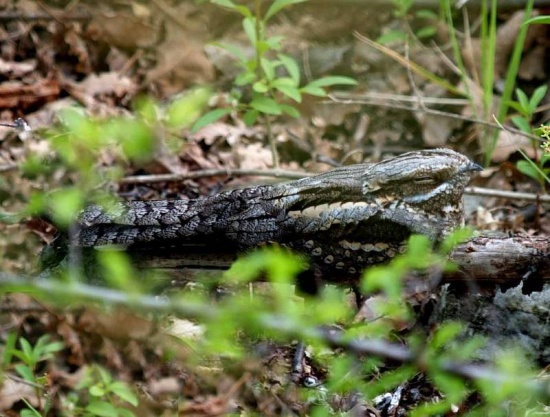- Caprimulgus europaeus
Identification
The plumage of the adult Nightjar is lichen-grey, barred and streaked with buff, chestnut and black. The under parts are barred. White spots on primaries and white tips to the outer tail feathers are characters of the male; in the young male these are buff. The bill is black, the legs reddish brown.
The variegated plumage resembles that of the Wryneck, its wide gape and long wings are like a swift’s, and its soft downy plumage and nocturnal habits are akin to an owls. The length is 26cm, and the wingspan 55cm.
The male may be told from the female by the white spots on his wings and tail, and as he gracefully floats above her, with wings upraised at a sharp angle, he spreads his tail wide to show the white spots. On the ground both birds will swing the tail from side to side when excited. The Nightjar does not hunt with open mouth, as often depicted, but the huge gape opens wide for large crepuscular insects, such as noctuid moths and dor-beetles, which are snapped up with avidity. Crepuscular insects are its food.
Distribution
Widespread summer visitor to much of the region. Breeds in Ireland (rare) and southern Britain and from Iberia east to the southern Urals and Caspian. In the north reaches south-east Norway and southern parts of Sweden and Finland, and across Russia north to about 62 degrees N. Also breeds south to the Mediterranean and on most larger islands, throughout Turkey and the Caucasus and from Morocco to Tunisia in North-West Africa. Range patchy and discontinuous in much of North-Western Europe and still in decline in many areas.
Begins to leave breeding areas in late July, by early October most have left for sub-Saharan Africa. The spring return movement is mainly April-May, rarely earlier.
Vagrant north to Iceland and Faroes, and west to the Azores, Madeira and Canary Islands.
Taxonomy
Subspecies Several races occur in the Region differing slightly in size, ground colour and amount of white in wings of male. Nominate race occurs over most of Western Palearctic range replaced in southern Europe, Turkey and North Africa by generally smaller and paler meridionalis. Other less differentiated raced races are found in the east of the Region but there is much intergradation and variation occurs within as well as between races.
Habitat
Dry open woodland and woodland edge, usually pine but also birch or oak, heathland and moorland with scattered trees, young forestry plantations and chalk downland. In some areas found on stony steppe country with sparse vegetation. Nocturnal
Behaviour
Bird Song
<flashmp3>Caprimulgus europaeus (song).mp3</flashmp3>
Listen in an external program




